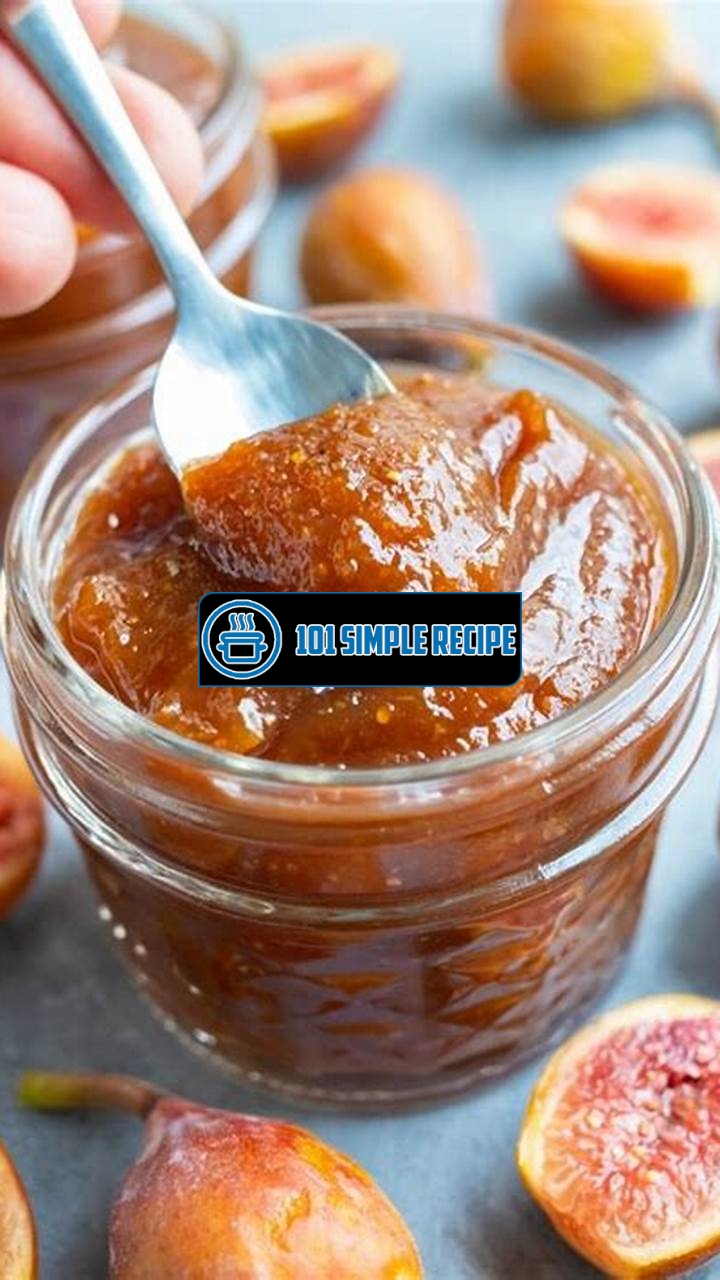Upgrade your fig jam recipe with this secret ingredient and take your tastebuds on a flavorful adventure! ✨ Imagine the sweet indulgence of figs enhanced by a surprising element that adds depth and complexity to your favorite spread. Whether you’re a seasoned chef or an amateur cook, this game-changing addition will elevate your fig jam to new heights. So, get ready to tantalize your senses and impress your loved ones with this irresistible twist! ️

Understanding Pectin in Fig Jam Recipes
When it comes to making delicious fig jam, one ingredient that plays a crucial role is pectin. Understanding what pectin is and its significance in fig jam recipes can help you take your culinary creations to the next level. So let’s delve deeper into this secret ingredient and uncover its mysteries!
What is Pectin?
In simple terms, pectin is a naturally occurring substance found in fruits, particularly in their peels, cores, and seeds. It acts as a thickening agent and is responsible for giving jams and jellies their desired texture. Pectin is a complex carbohydrate and forms a gel-like consistency when mixed with water and sugar.
Fun fact: The word “pectin” is derived from the Greek word “pektos,” which means “congealed” or “curdled.” This perfectly describes the texture that pectin imparts to your fig jam!
Why is Pectin Used in Fig Jam Recipes?
Pectin is a key component in fig jam recipes for several reasons. Firstly, it helps the jam thicken and set properly, giving it that irresistible spreadable texture. Without pectin, your fig jam might turn out too runny or watery.
Additionally, pectin contributes to the overall shelf life of the jam. It acts as a natural preservative, allowing your fig jam to stay fresh for a longer duration. This is particularly important if you plan on storing your homemade jam for future use or gifting it to friends and family.
Moreover, pectin enhances the flavor and aroma of fig jam. It helps the jam retain the natural sweetness of the figs while balancing the acidity of other ingredients, resulting in a harmonious blend of flavors.
Different Types of Pectin for Fig Jam Recipes
There are a few different types of pectin available for use in fig jam recipes. Understanding their distinctions can help you choose the right one for your culinary endeavors.
1. Powdered Pectin: This type of pectin is most commonly used in homemade fig jam recipes. It is easy to work with and provides consistent results. Powdered pectin is mixed with sugar before being added to the simmering fruit mixture, ensuring proper dispersion.
2. Liquid Pectin: Liquid pectin is another popular option for making fig jam. It is usually added towards the end of the cooking process and requires less cooking time compared to powdered pectin. Liquid pectin is highly concentrated, so make sure to follow the manufacturer’s instructions for proper usage.
3. Low-Methoxyl Pectin: This type of pectin is commonly used in low-sugar or no-sugar fig jam recipes. It requires the addition of calcium to activate its gelling properties. Low-methoxyl pectin allows you to reduce the amount of sugar used in your jam without sacrificing its texture or flavor.
Note: Regardless of the type of pectin you choose, always follow the recipe instructions and ratios to ensure successful results.
Now that you have a better understanding of pectin and its significance in fig jam recipes, you can confidently upgrade your culinary skills and create the most amazing fig jam ever! So go ahead, gather your ingredients, and let the magic of pectin unfold in your kitchen!
The Science Behind Pectin in Fig Jam
In the world of fig jam recipes, one secret ingredient stands out: pectin. This natural substance plays a crucial role in achieving the perfect texture, consistency, flavor, and shelf life of fig jam. By delving into the scientific aspects of pectin, we can better understand its significance and how it enhances this delectable spread.
How Does Pectin Work in Fig Jam?
Pectin is a complex carbohydrate found in the cell walls of fruits. When heated with sugar and acid, such as lemon juice, pectin undergoes a process called gelation. This process is essential in fig jam recipes as it transforms the mixture into a spreadable consistency. As the fig jam cools, the pectin forms a gel-like structure that traps the fruit’s natural juices and sets the jam.
⭐️ Pectin enables the gel formation in fig jam, giving it the desired texture.
⭐️ The gel traps the fruit juices, ensuring a spreadable consistency.
The Role of Pectin in Texture and Consistency
The amount of pectin used in a fig jam recipe is crucial in determining its texture. Some recipes call for commercial pectin, while others rely on naturally occurring pectin in the fruit. Commercial pectin provides a more predictable result, especially for those seeking a firmer jam.
⭐️ Commercial pectin helps achieve a consistent texture, ideal for those who prefer a firmer fig jam.
⭐️ Naturally occurring pectin may result in a slightly softer texture, giving the jam a more rustic appeal.
Additionally, the cooking time and temperature also impact the texture and consistency of fig jam. Overcooking can break down the pectin, leading to a runny jam, while undercooking can result in a grainy texture. Achieving the perfect balance is essential for a smooth and enjoyable fig jam.
Effects of Pectin on Flavor and Shelf Life of Fig Jam
Pectin not only influences the texture but also affects the flavor and shelf life of fig jam. Its presence contributes to a distinct fruity taste and enhances the overall sensory experience. Pectin also acts as a natural preservative, prolonging the shelf life of the jam.
⭐️ The pectin in fig jam intensifies the natural flavor of the figs, resulting in a rich and fruity taste.
⭐️ The natural preservative properties of pectin help extend the shelf life of fig jam, ensuring it stays fresh for a longer duration.
NOTE: It is important to note that excessive use of pectin can lead to an overly firm jam with an unnatural taste. It is recommended to follow the recipe guidelines and adjust the pectin quantity according to personal preference.
In conclusion, understanding the science behind pectin in fig jam recipes is essential for achieving the perfect spread. By controlling the pectin content, cooking time, and temperature, you can create a delicious and well-textured fig jam that will leave your taste buds yearning for more.
Finding the Perfect Pectin for Your Fig Jam
When it comes to making the perfect fig jam, selecting the right pectin is essential. Pectin, a natural substance found in fruits, is what gives jam its gel-like consistency. However, with so many pectin options available in the market, it can be overwhelming to determine which one is best for your fig jam recipe. To help you make an informed decision, let’s explore the factors to consider when selecting the perfect pectin for your fig jam.
Understanding Pectin Strength and Gel Setting
One important factor to consider when choosing pectin for your fig jam is its strength and gel setting properties. Pectin strength refers to the amount of pectin needed to achieve a firm gel in your jam. Some pectins are designed for low-sugar recipes, while others are better suited for high-sugar recipes. Consider the desired sweetness level of your fig jam and choose a pectin that matches your preferences.
Additionally, the gel setting properties of pectin determine the texture and consistency of your jam. Some pectin brands offer various options, such as firm, medium, or soft gel setting. Think about the desired thickness of your fig jam and select a pectin that will give you the perfect gel consistency.
- Key factor: Pectin strength and gel setting determine the firmness and texture of your fig jam.
- Tip: Choose a pectin that matches the desired sweetness level and gel consistency of your jam.
Choosing between Liquid and Powdered Pectin
Another decision to make when selecting pectin for your fig jam is whether to use liquid or powdered pectin. Both types have their advantages and drawbacks, so it’s important to consider your personal preferences and cooking style.
Liquid pectin is convenient to use as it can be simply poured into the jam mixture. It is also known for producing a smoother texture in jams. On the other hand, powdered pectin is easier to measure precisely and has a longer shelf life. It often requires mixing with sugar before adding it to the jam mixture.
- Key factor: Choose between liquid or powdered pectin based on your preference and cooking style.
- Tip: Liquid pectin offers convenience and smooth texture, while powdered pectin allows for precise measurement and longer shelf life.
Natural Pectin Sources for Fig Jam Recipes
If you prefer to make your fig jam using natural ingredients, there are several natural pectin sources you can explore. Many fruits, such as apples and citrus fruits, naturally contain pectin and can be used to achieve the desired gel consistency in your jam. Simply add these fruits to your fig jam recipe to enhance its natural pectin content.
Another natural pectin source is homemade pectin, which can be made from apple peels and cores. By simmering the peels and cores in water and extracting the liquid, you can create your own pectin solution to use in your fig jam recipe. This option is perfect for those who prefer a completely homemade and natural approach.
- Key factor: Natural pectin sources include fruits like apples and homemade pectin made from apple peels and cores.
- Tip: Enhance the natural pectin content of your fig jam by adding pectin-rich fruits or creating homemade pectin from apple scraps.
Now armed with this knowledge, you can confidently select the perfect pectin for your fig jam recipe. Consider the pectin strength and gel setting properties, choose between liquid or powdered pectin based on your preferences, and explore natural pectin sources for a homemade touch. Happy jam-making!
Using Pectin Properly in Fig Jam Recipes
When it comes to making the perfect fig jam, incorporating pectin effectively in your recipe is key. Pectin is a natural substance found in fruits that helps create that desirable, thick consistency in jams and jellies. By mastering the techniques and tips for using pectin properly, you can take your fig jam recipe to the next level.
Measuring and Adjusting Pectin Quantity
Getting the right amount of pectin in your fig jam recipe is crucial for achieving the desired consistency. The amount of pectin needed depends on factors such as the ripeness of the figs and the desired thickness of the jam. It’s essential to follow the recommended measurements provided on the pectin packaging or in trusted recipes.
However, keep in mind that you may need to adjust the amount of pectin based on your personal preference. If you prefer a thicker jam, you can add a bit more pectin to the recipe. On the other hand, if you prefer a looser consistency, you can reduce the amount of pectin used. Remember to make small adjustments and test the result before making larger batches.
Factors that Impact Pectin Effectiveness
In addition to measuring the pectin quantity accurately, several factors can impact its effectiveness in your fig jam recipe. The acidity level of the fruit plays a significant role in the gelling process. Make sure the figs you use are ripe but not overly ripe, as the pectin content decreases as fruits become overly ripe.
The sugar content is also crucial for pectin effectiveness. Too much sugar can hinder the gelling process, while too little sugar can result in a runny texture. Finding the right balance is key to achieving the perfect consistency in your fig jam.
Furthermore, the cooking time and temperature can affect the pectin’s ability to set. Overcooking can cause pectin to break down and result in a runny jam. It’s important to follow the recommended cooking instructions and use a thermometer if necessary to ensure the jam reaches the proper temperature for setting.
Combining Pectin with Other Ingredients for Best Results
While pectin is the star ingredient when it comes to achieving a thick consistency in fig jam, combining it with other ingredients can enhance the overall flavor and texture. Adding lemon juice, for example, can increase the acidity and help the pectin gel more effectively.
Some recipes also call for the addition of spices like cinnamon or nutmeg to enhance the taste of the fig jam. These ingredients not only add flavor but also contribute to the overall mouthfeel of the jam.
Experimenting with different combinations of fruits can also yield unique and delicious results. For example, adding a small amount of apple or orange can complement the flavor of figs and contribute to the pectin’s gelling properties.
Note: Remember to taste and make adjustments as you go when combining pectin with other ingredients. The goal is to create a balanced and flavorful fig jam.
By incorporating pectin properly, measuring and adjusting the quantity, understanding the factors that impact its effectiveness, and combining it with other ingredients wisely, you can upgrade your fig jam recipe to a whole new level of deliciousness. Start experimenting and mastering these techniques, and get ready to enjoy a truly exceptional fig jam!
Homemade Pectin Alternatives for Fig Jam
When it comes to making fig jam, achieving the perfect texture and consistency without using commercial pectin can be a challenge. However, there are alternative methods that you can explore to enhance the natural pectin content and create a delicious fig jam. In this article, we will delve into three main approaches to achieving the desired results: using cooking techniques, exploring fruit-based pectin substitutes, and understanding the role of acid and sugar in pectin alternatives.
Using Cooking Techniques to Enhance Natural Pectin Content
One effective way to boost the natural pectin content in your fig jam is by incorporating specific cooking techniques. By applying these techniques, you can extract pectin from the ingredients themselves, which will help to thicken the jam. Here are a few cooking techniques that you can try:
- Cooking fruits for a longer duration: By simmering the fruits for an extended period of time, you allow the pectin present in the fruits to release and bind the jam together. This method works particularly well with figs, as they are naturally high in pectin.
- Using a slow cooker: Slow cooking the figs allows them to break down slowly, encouraging the release of pectin. This method also intensifies the flavors of the figs, resulting in a richer tasting jam.
- Adding citrus peels: Citrus peels, specifically lemon or orange, are rich in pectin. Including them in your fig jam recipe will not only enhance the pectin content but also add a bright, citrusy flavor. Make sure to remove the peels before jarring the jam.
Exploring Fruit-Based Pectin Substitutes
If you prefer to avoid using commercial pectin altogether, there are several fruit-based alternatives that you can experiment with. These alternatives utilize the natural pectin found in certain fruits to achieve the desired consistency. Some popular fruit-based pectin substitutes for fig jam include:
- Apples: Apples are known for their high pectin content. Adding finely chopped or grated apples to your fig jam mixture can help thicken it naturally.
- Citrus fruits: As mentioned earlier, citrus fruits like lemons and oranges are excellent sources of pectin. Utilize their juice or zest to augment the pectin levels in your fig jam.
- Quinces: Quinces are a lesser-known fruit that is exceptionally high in pectin. Cooking quinces and incorporating them into your fig jam will undoubtedly enhance its texture and consistency.
Understanding the Role of Acid and Sugar in Pectin Alternatives
Acid and sugar play crucial roles in the effectiveness of pectin alternatives. They help activate and stabilize the pectin, thereby creating the desired gel-like texture in your jam. It’s important to strike the right balance of acid and sugar in your fig jam recipe to ensure optimal results. Here are a few things to consider:
- Acid: Adding a small amount of lemon juice or citric acid to your fig jam not only enhances the flavors but also activates the pectin. Citrus fruits are great sources of natural acids and can be used accordingly.
- Sugar: Sugar acts as a preservative and also helps with the gelling process. Be mindful of the sugar-to-fruit ratio in your fig jam recipe as it directly affects the setting of the pectin.
- Testing for desired consistency: To determine if your fig jam has reached the desired consistency, you can perform a gel test. Simply place a small amount of the cooked jam on a chilled plate and let it cool. If it forms a gel-like texture, you have achieved the perfect consistency.
By utilizing cooking techniques, exploring fruit-based pectin substitutes, and understanding the role of acid and sugar in pectin alternatives, you can upgrade your fig jam recipe with ease. These methods not only provide delicious results but also allow you to control the ingredients used in your homemade fig jam. So why not give them a try and elevate your fig jam-making game to the next level?
Thank you for taking the time to read our article on fig jam recipe with pectin. We hope you found this recipe enjoyable and informative. If you’re looking to indulge in a sweet and tangy homemade fig jam, this recipe is sure to satisfy your taste buds. Create a jar of this delightful spread to enjoy on toast, sandwiches, or even as a condiment for cheese plates. Be sure to bookmark our page and visit again for more delicious recipes and culinary inspiration!
Frequently Asked Questions
Here are some frequently asked questions about making fig jam with pectin:
| No. | Questions | Answers |
|---|---|---|
| 1. | What is pectin and why is it used in this recipe? | Pectin is a natural carbohydrate found in fruits that acts as a thickening agent. It is used in this recipe to help achieve the desired consistency of the fig jam. |
| 2. | Can I use a different type of fruit instead of figs? | While this recipe specifically focuses on fig jam, you can certainly experiment with other fruits. Just make sure to adjust the pectin and sugar amounts accordingly. |
| 3. | How long does the fig jam last? | When stored in an airtight container in the refrigerator, the fig jam can last for up to two weeks. |
| 4. | Can I use frozen figs instead of fresh ones? | Yes, frozen figs can be used in this recipe. Just make sure to thaw them before starting the cooking process. |
| 5. | Is it necessary to sterilize the jars before filling them with the jam? | Yes, it is recommended to sterilize the jars to ensure the jam stays fresh for longer. This can be done by submerging the jars in boiling water for a few minutes. |
| 6. | Can I adjust the amount of sugar in the recipe? | Yes, the amount of sugar can be adjusted according to your personal preference. Just keep in mind that it may affect the overall taste and texture of the jam. |
Closing Thoughts
We hope you enjoyed learning how to make fig jam with pectin. The combination of fresh figs, sugar, and pectin creates a luscious and flavorful spread that can be enjoyed in various ways. Whether you’re hosting a brunch or simply craving a sweet treat, this fig jam recipe is a must-try. Don’t forget to check back later for more delectable recipes and culinary adventures. Happy cooking!
Jump to Recipe
Fig Jam Recipe with Pectin

Learn how to make a delicious fig jam with pectin. This sweet and tangy spread is perfect for toast, sandwiches, and more.
- 2 pounds fresh figs
- 2 cups granulated sugar
- 1/4 cup lemon juice
- 1 tablespoon powdered pectin
- Wash the figs under cold water and remove the stems. Cut the figs into quarters and set aside.
- In a large saucepan, combine the figs, sugar, and lemon juice. Cook over medium heat until the figs break down and the mixture thickens, stirring occasionally. This process may take about 30 minutes.
- Dissolve the powdered pectin in a small amount of water. Stir the pectin mixture into the fig jam and continue cooking for an additional 5 minutes.
- Remove the saucepan from heat and let the fig jam cool slightly. Transfer the jam into sterilized jars and seal tightly. Store in the refrigerator for up to two weeks.






